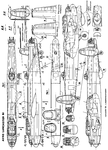FLYBOYJ
"THE GREAT GAZOO"
The B-24 becuase a pig when it lost one or more engines or when the wing itself was damaged, at that point the Davis airfoil ceased to be effective. I think today the last of the Lancs that are flying require a second pilot by order of the CAA.bomber said:From sitting in the pilots seat of the Lancaster I'd say it was pretty easy to drag a wounded pilot out of it and into the lower side well...
The Lancster was fitted as a norm with only one yoke, but a second could have been fitted it it has been felt that one was needed but it never was, so that in itself must say something surely
And the b24 was noted as a pig to fly, very heavy controls.. it probably needed 2 men on the controls in a storm
Simon
the lancaster kicks *** said:the Pilot was the most expensive crew member to train, putting two in every bomber would cost twice as much as putting one in every bomber. The next bit of logic is that there will always be some attacks that even a second pilot can't save you from, such as your fuel blowing up and ripping the aircraft to shreads, so you've lost two pilots in one go and there was no point in having the other pilot. The RAF figured they'd put this extra pilot in annother aircraft, that way they can, for the same money as having a co-pilot, put an extra 14,000lbs on target, furthermore if the one plane has that attack that no co-pilot can save you from, you've only lost one pilot not two, because the other one's miles away in a completely different plane! slightly morbid thinking perhaps, but in a way it makes sence, experience with the twin pilot stirling made them think there's not many situations where a co-pilot can save you, and they occour so rarely that it's not worth the extra expence.........
While Lanc brings up good points in the early WW2 way of thinking about crew resources, a second pilots proved to be the safer and more reliable course to go. It was proven that the pilot can go into "overload." Too many things happening for him to keep control of the aircraft. Battle damage, bad weather, wounded or incapacitated crew members, etc. Combine this with a low time pilot (200-300 hours) it could be a set up for disaster and this is the only thing I think the B-17 and B-24 had over the Lanc. Pilot resources were scarce for the RAF, especially early in the war so I understand the rationalle for going with the a single pilot in large multi-engine aircraft. There were early instrument landing procedures used over England and they were difficult enough to fly under routine conditions, accomplish them at night with a damaged aircraft and one pilot, it's a disaster waiting to happen.
Taking nothing away from the brave and skilled crews of the Lancaster, I think many more would of made it home had the aircraft been equipped with a second pilot.


